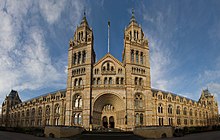陶瓦
陶瓦(Terracotta、Terra cotta 或 Terra-cotta,意大利文:“烤过的土”,[1]从拉丁语:terra cotta而来),又称粗陶、赤陶,是一种陶器,以粘土为原料,上釉或者是不上釉。[2] 器体本身为多孔设计。[3][4][5][6] 陶瓦被运用在许多器物上(最常被用在花瓶)、水道、屋瓦还有建筑工程的外部装饰,还有雕像如秦始皇兵马俑。陶瓦同时也可以指运用这个材料所做成的物品,或者是陶瓦的原色(棕色),这个范围相当大。在考古学与艺术史中,“陶瓦”通常指那些不是用陶工轮所制造的物品。
| 赤陶色 | |
|---|---|
| 网页颜色 | #B66655 |
| RGBB (r, g, b) | (182, 102, 85) |
| CMYH (c, m, y) | (29, 60, 67) |
| CMYKH (c, m, y, k) | (0, 44, 53, 29) |
| HSL (h, s, l) | (11°, 40%, 52%) |
| HSV (h, s, v) | (11°, 53%, 71%) |
| HWB (h, w, b) | (11°, 33%, 29%) |
| B:代表值域介于0~255之间 | |
| H:代表值域介于0~100之间 | |






生产和特性
编辑一个适当品质好的粘土被塑造为所需的形状。干燥后,它被放置在一个窑中然后烧制。典型的烧成温度为1000℃,其中的铁含量,使得烧结体呈现出黄色、橙色、红色、粉红色、灰色或褐色。燃烧过后的陶瓦并不防水,然而若在燃烧之前将表面抛光则可以减少表面的孔,此外,釉层可以使其防水。这适合作为在热带环境中的花园或建筑的装饰,以及耐油容器,油灯,或烤箱。 大多数其他用途,会运用在餐具,卫生下水道,而在寒冷的环境,这种器具需要上釉面。陶瓦如果无裂纹,轻轻地拍击将会发出声响。某些陶瓦是从回收的陶瓦中制造的。
参考
编辑- ^ Merriam-Webster.com. [2012-11-20]. (原始内容存档于2021-05-19).
- ^ OED, "Terracotta"
- ^ ‘Diagnosis Of Terra-Cotta Glaze Spalling.’ S.E. Thomasen, C.L. Searls. Masonry: Materials, Design, Construction and Maintenance. ASTM STP 992 Philadelphia, USA, 1988. American Society for Testing & Materials.
- ^ ‘Colour Degradation In A Terra Cotta Glaze’ H.J. Lee, W.M. Carty, J.Gill. Ceram.Eng.Sci.Proc. 21, No.2, 2000, p.45-58.
- ^ ‘High-lead glaze compositions and alterations: example of byzantine tiles.’ A. Bouquillon. C. Pouthas. Euro Ceramics V. Pt.2. Trans Tech Publications, Switzerland,1997, p.1487-1490 Quote: “A collection of architectural Byzantine tiles in glazed terra cotta is stored and exhibited in the Art Object department of the Louvre Museum as well as in the Musee de la Ceramique de Sevres.”
- ^ 'Industrial Ceramics.' F.Singer, S.S.Singer. Chapman & Hall. (*1971)Quote: "The lighter pieces that are glazed may also be termed 'terracotta.'
外部链接
编辑- Article on terracotta in Victorian and Edwardian Terracotta Buildings
- Bibliography,Smithsonian Institution,Ceramic Tiles and Architectural Terracotta
- Tile Heritage Foundation (页面存档备份,存于互联网档案馆)(US)
- Friends of Terra Cotta (页面存档备份,存于互联网档案馆),non-profit foundation to promote education and preservation of architectural Terracotta
- Tiles and Architectural Ceramics Society (页面存档备份,存于互联网档案馆)(UK)
- La Terracotta (页面存档备份,存于互联网档案馆)(IT)